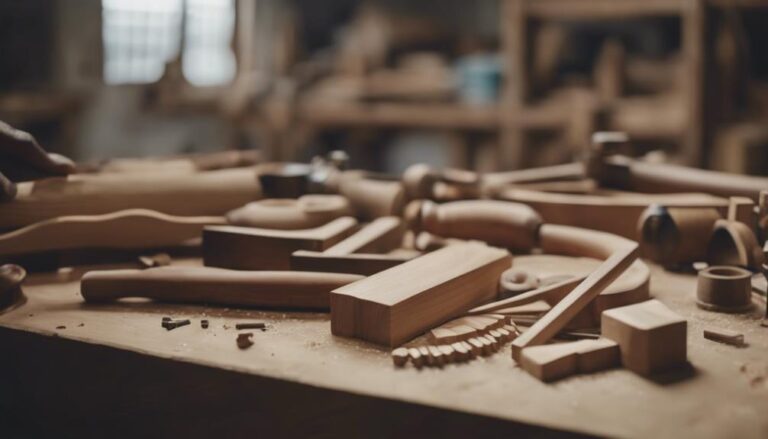In the world of woodworking in South Africa, the selection of wood joinery techniques plays a pivotal role in the craft landscape. The top three wood joinery preferences in this region have been carefully curated, each serving a distinct purpose in the crafting of wooden structures.
These preferences encapsulate a fusion of tradition, innovation, and functionality, catering to the varied needs of woodworkers and artisans. By delving into the nuances of these favored techniques, a deeper appreciation for the artistry and expertise involved in woodworking unfolds, illuminating the intricate web of joinery practices in South Africa.
Key Takeaways
What are the top three wood joinery preferences in South Africa? How do these techniques embody strength, durability, and beauty in woodworking projects? Discover exquisite wooden products that showcase craftsmanship and precision. Shop now for pieces that stand the test of time at Holzfleck.
Popular Wood Joinery Choices
Popular Wood Joinery Choices
Woodworkers in South Africa exhibit a preference for a diverse array of wood joinery techniques, with the traditional mortise and tenon joint standing out for its renowned strength and durability. This method involves inserting a projecting tenon into a precut mortise, creating a strong and reliable connection that can withstand significant stress. Beyond its exceptional strength, the mortise and tenon joint also adds a touch of traditional aesthetics to the wooden pieces, showcasing the craftsmanship and attention to detail of South African woodworkers.
In addition to the emphasis on strength, South African woodworkers also value the aesthetic appeal of their creations. Dovetail joints, known for their interlocking wedge-shaped fingers that increase resistance to pulling forces, are favoured for their visual appeal in fine furniture making. This combination of strength and aesthetics is a hallmark of the woodworking tradition in South Africa, where each joint serves not only a functional purpose but also contributes to the overall beauty of the piece.
Traditional Joinery Techniques
In the realm of woodworking craftsmanship in South Africa, traditional joinery techniques play a pivotal role in shaping the structural integrity and visual appeal of wooden creations. Craftsmen in South Africa exhibit a profound dedication to joinery craftsmanship, utilising historical techniques that have stood the test of time.
Traditional Joinery Techniques:
- Mortise and Tenon Joints: Widely favoured for their robustness and ability to withstand heavy loads, these joints are meticulously crafted to ensure a seamless fit.
- Dovetail Joints: Renowned for their interlocking design, dovetail joints are not only strong but also add a touch of elegance to furniture pieces.
- Lap Joints: Known for their simplicity and effectiveness, lap joints are frequently used in South African woodworking to join different sections of timber securely.
The historical significance of these traditional joints is deeply ingrained in South African woodworking practices, reflecting a commitment to preserving heritage and upholding the principles of quality craftsmanship passed down through generations.
Emerging Joinery Trends
Emerging Joinery Trends
Emerging joinery trends in South Africa are reshaping the landscape of woodworking craftsmanship, incorporating modern techniques and materials while honouring the legacy of traditional joinery practices. Woodworkers in South Africa are increasingly turning to modern machinery and tools to achieve precise and efficient joints, moving away from solely relying on traditional methods like mortise and tenon joints. This shift towards modern equipment allows for increased accuracy and speed in joinery projects, catering to the demands of contemporary design and construction.
Furthermore, there is a notable trend towards utilising indigenous wood species such as Yellowwood and Stinkwood in joinery projects. These native woods not only offer unique aesthetics but also showcase the rich diversity of South Africa's natural resources. By incorporating these local woods, woodworkers are creating pieces that reflect a strong sense of place and identity.
In addition, sustainability is becoming a key focus in South African wood joinery, with more artisans opting for eco-friendly practices. This includes using reclaimed or recycled wood for joints, reducing waste and environmental impact. Collaborations with local artisans and craftsmen are also on the rise, fostering community support and enabling the sharing of valuable skills and knowledge within the woodworking industry.
Conclusion
In summary, the top three wood joinery preferences in South Africa – dovetail joints, mortise and tenon joints, and biscuit joints – embody a harmonious blend of strength, durability, and beauty in woodworking projects. These time-honoured and innovative joinery techniques are vital in crafting exquisite furniture and woodwork items. Woodworkers in South Africa place great emphasis on practicality, reliability, and effectiveness when choosing joinery methods for their creations.
If you're looking for top-quality wooden products that resonate with craftsmanship and skill, why not shop for them on our site today? Discover a range of meticulously crafted pieces that embody the artistry and precision of wood joinery techniques.
At Holzfleck, we understand the importance of creating pieces that stand the test of time. If you're interested in incorporating these superior wood joinery methods into your own projects, don't hesitate to request a quote from us. Our team is here to help bring your woodworking visions to life with expertise and dedication.




